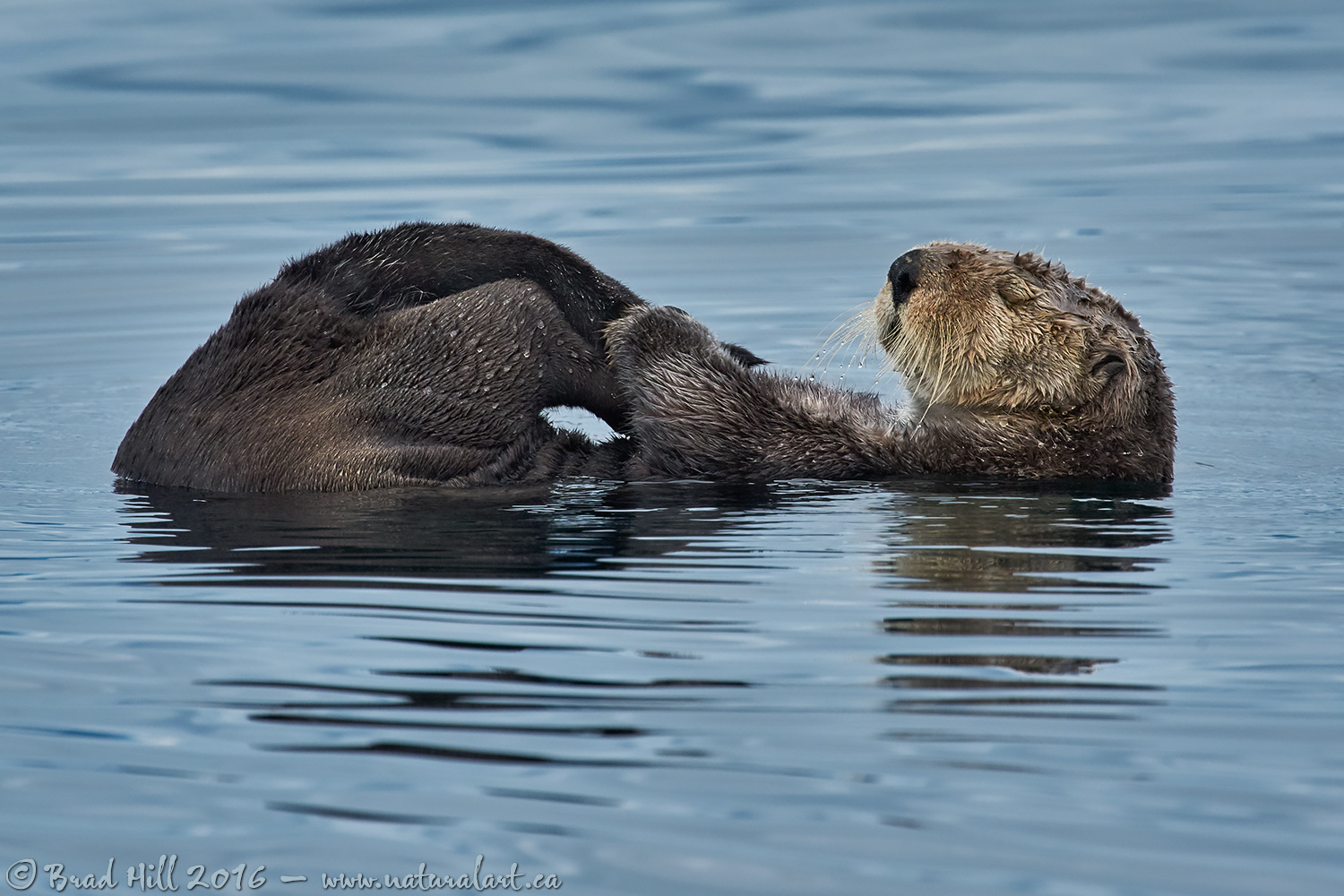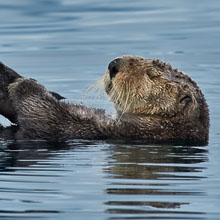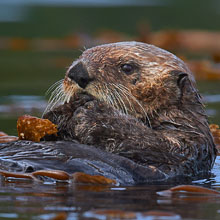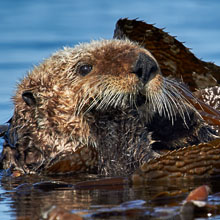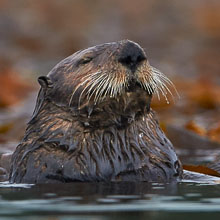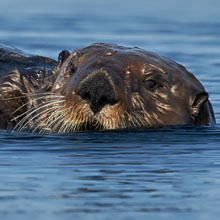Availability: Undetermined - Enquiries?
In the Field
Water Bed. Johnstone Strait Region, Northern Vancouver Island, BC, Canada. August 8, 2015.
I find sea otters fascinating. Evolution is never fully linear - it doesn't necessarily move towards a single, unitary "solution" to a life problem. Over time a lot of different solutions or pathways are "experimented with" (teleologically speaking, of course!) to solve basic problems faced by all life. As a warm-blooded animal living in a cold, aquatic environment sea otters (and all other marine mammals) must find a way to battle heat loss. Every single marine mammal on earth - except the sea otter - does it by adding a thick, insulating layer of fat (or "blubber") under their skin. Sea otters have come up with (again...teleologically speaking!) a totally unique solution; they use a thick, luxuriant coat - combined with a high metabolic rate - to fend off the heat-sucking properties of the water they live in. That coat requires constant care (preening) to keep it filled with natural oils (for water repellency) and filled with air (for buoyancy). When sea otters coats have just finished caring for their coat - an almost never-ending job - they are amazing buoyant and almost float on top of the water. THIS sea otter has JUST finished a long preening bout (finishing with its curled tail) and is dropping off to sleep, laying on top of the water - and making it look like a firm mattress or water bed! No worries about this cute fuzzy dude sinking!
Back to the image: On the creative side...I chose to keep this image subtle and kind of "low key" during post-processing. We had a mix of sun and cloud at the time I shot this, and most of the otter was "lightly shaded", with only the left hip and facial region getting slightly more direct light (though still not direct sunlight). To me the visually appealing aspects of the original scene were the water droplets, subtle tonal (and hue) shifts on the coat of the otter, and those faint "beams" of light. Of course, I didn't particularly mind the cute pose of the female sea otter! ;-)
And...on the technical side, I captured this image using a pretty long total focal length - a 400mm lens (a Nikkor 400mm f2.8E VR) paired with a 2x teleconverter (a TC-20EIII), thus a 800mm total focal length. And, given the nature of how we were working with these guys (i.e., from a floating Zodiac) - I was forced to hand-hold the lens. This lens/TC combination does perform very well, yet I wasn't totally happy with the absolute sharpness of all parts of the otter. Over the years I have learned what can and can't be "recovered" using standard sharpening techniques (be it using Unsharp Mask or Smart Sharpen in Photoshop OR in a raw converter). Fortunately, there's a relatively "new kid" on the block in image sharpening - the Shake Reduction filter in Photoshop CC (don't ask me which version it was introduced in....with the CC "model" it's becoming harder to keep track of what is introduced when!). This complex filter is actually designed to remove the effects of camera shake and looks to "rebuild" the image where it detects directional "blurs" in an image. BUT, I have found another use for it - for selective sharpening portions of an image in situations where "traditional" sharpening techniques won't work.
Detailed discussions of what can and can't be done with the Shake Reduction filter and the method I've come up to use the Shake Reduction filter "outside its intended use" go WAY beyond what I can go into here, but it invariably involves "toning down" the effect through use of masking and/or adjusting layer opacity, and it is definitely super easy to overdo the effect, especially in portions of an image with many fine lines (applying this filter to the whiskers would have made a complete mess of them!). In this image I used "throttled down" Shake Reduction on the "thigh" region of the left hind leg (around the water droplets) and in a portion of the neck region along the waterline.
Here's higher-resolution (2400-pixel) version of this shot for the sea otter lovers out there:
• Water Bed. Download 2400 pixel image (JPEG: 1.3 MB)
ADDITIONAL NOTES:
1. This image - in all resolutions - is protected by copyright. I'm fine with personal uses of them (including use as desktop backgrounds or screensavers on your own computer), but unauthorized commercial use of the image is prohibited by law. Thanks in advance for respecting my copyright!
2. This image was captured during my "Humpbacks, Orcas, Sea Lions & More" Marine Mammals photo tour in August of 2015. Each year I offer trips into two different parts of the Great Bear Rainforest as well as one to photograph marine mammals and oceanscapes near the northern tip of Vancouver Island. And, in selected years, I also offer photo tours to locations to capture other highly sought-after subjects, such as various owl species of the boreal forest and wildlife of Canada's Arctic. Details about these trips can be found on the Photo Tours page of this website.
3. Like all wildlife photographs on this website, this image was captured following the strict ethical guidelines described in The Wildlife FIRST! Principles of Photographer Conduct. I encourage all wildlife photographers to always put the welfare of their subjects above the value of their photographs.
Behind the Camera
Water Bed. Johnstone Strait Region, Northern Vancouver Island, BC, Canada. August 8, 2015.
Digital Capture; Compressed RAW (NEF) 14-bit format; ISO 1400.
Nikon D750 paired with Nikkor 400mm f2.8E VR plus TC-20EIII (2.0x) teleconverter, for a total focal length of 800mm. Hand-held from floating Zodiac. VR on and in "Sport" mode.
1/800s @ f11; +0.67 stop compensation from "recommended" matrix-metered exposure setting.
At the Computer
Water Bed. Johnstone Strait Region, Northern Vancouver Island, BC, Canada. August 8, 2015.
RAW Conversion to 16-bit TIFF using Phase One's Capture One Pro 9. Four raw variants (different versions of a single raw capture) processed, with the variants differing in exposure (0.5 stop total difference between the variants) and shadow and highlight retrieval settings, and in white balance settings.
Further digital corrections on resulting 16-bit TIFF files using Adobe's Photoshop CC 2015 and Light Crafts Lightzone. Photoshop adjustments included compositing (blending) of the four output files from the raw converter, minor exposure tweaks, selective use of the Shake Reduction filter and final selective sharpening for web output. Final tone-tweaking performed using LightZone's "tonemapper" tool.
Conservation
Water Bed. Johnstone Strait Region, Northern Vancouver Island, BC, Canada. August 8, 2015.
Ten percent of the revenue generated by this image will be donated to Raincoast*.
Species Status in Canada**: Special Concern (April 2007) - protected off the North American coast since 1911.
Back in the late 1800's and early 1900's the Sea Otter (Enhydra lutris) was hunted to near extinction along both the Asian and North American Pacific Coasts. The reason? It's luxuriant coat. Otters are unlike any other aquatic mammal in that they don't use fat or blubber to insulate themselves from the chilling effects of the water they are found in. Instead, they rely on their amazingly thick fur coat for insulation. Their amazing coats have a higher density of hair (up to 150,000 strands of hair per square cm!) than any other animal in existence today. To ensure that this coat serves its insulative purpose, otters spend a disproportionately large amount of time grooming their coat (to ensure its natural oils continue to provide an effective waterproof barrier). Unfortunately, the biological functioning of the otters coat can be easily fouled by contamination by oil and other hydrocarbons - thus making them extremely sensitive to the effective of marine oil spills.
Other fascinating aspects of the biology and behaviour of the sea otter include the use of tools (they will use rocks to break apart shellfish such as sea urchins), and the fact that they have an metabolic rate two to three times higher than other mammals of their size. This means they must eat 23% to 33% of their own body weight DAILY, just to to replace the calories burned through maintaining their body temperature in the cold water environment they live in.
*The Raincoast Conservation Society (and Foundation) is an effective and efficient organization that has been fighting for protection of this unique habitat. If you are looking for a meaningful way to contribute to the conservation of this amazing ecosystem, Raincoast will provide maximal "bang" for your conservation dollars.
**as determined by COSEWIC: The Committee on the Status of Endangered Wildlife in Canada












